In today’s rapidly evolving digital landscape, the advent of Software as a Service (SaaS) solutions has completely transformed the way businesses function and deliver their services to clients. SaaS offerings bring unmatched levels of adaptability, scalability, and accessibility, making them the preferred choice for organizations seeking to streamline their operations and elevate customer experiences. Nevertheless, achieving success in a SaaS project hinges not solely on the quality of the software itself, but also on the adeptness of project management.
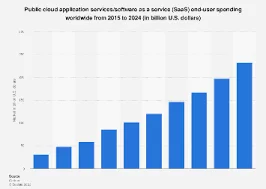
What is Saas Project Management?
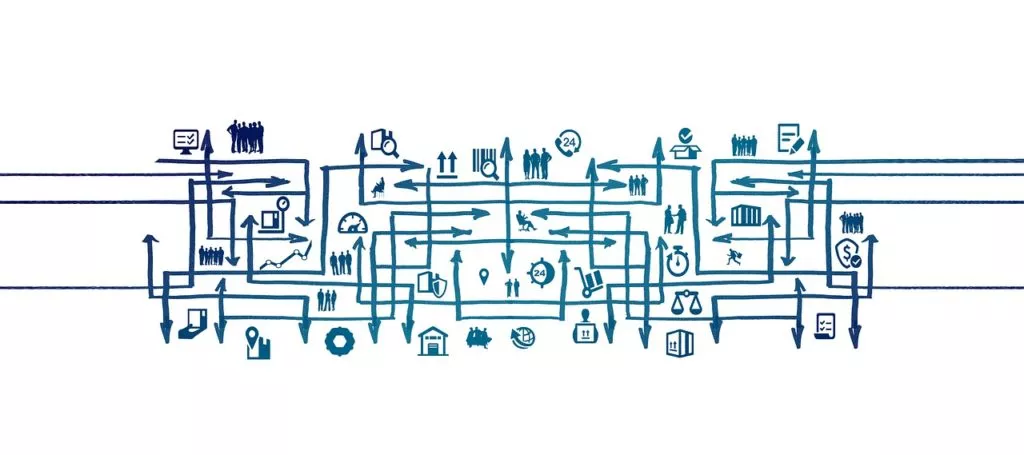
SaaS Project Management encompasses the intricate process of guiding a team through the creation of a successful Software-as-a-Service (SaaS) product or feature. The unique characteristics of SaaS products, including their short development cycles, rapid adaptation to market demands, and the necessity for ongoing maintenance and updates, make this form of project management particularly demanding.
In SaaS, where agility is paramount, project managers must exhibit exceptional organizational skills while meticulously adhering to project timelines. They are responsible for a multitude of tasks, including:
- Team Coordination: Effectively organizing development, design, and marketing teams to ensure they work cohesively to meet deadlines. Collaboration and synchronization are key in this fast-paced environment.
- Product Planning: Devising a comprehensive product plan that encompasses the creation of the initial Minimum Viable Product (MVP) and the roadmap for future feature updates. This involves setting a clear vision and strategy to align with the evolving needs of the target market.
- Issue Tracking: Vigilantly monitoring and managing bugs and tickets to maintain product quality and user satisfaction. Effective issue tracking and resolution are crucial for sustaining a positive user experience.
- Feedback: Coordinating the collection and analysis of user feedback is vital. This feedback loop aids in identifying user needs, pain points, and preferences, which can inform subsequent development and improvement efforts.
- Stakeholder Engagement: Maintaining open and effective communication with key stakeholders, including business leaders and clients, to ensure the project aligns with overarching business goals and satisfies client expectations.
Why Are SaaS Project Management Tools Essential?
Now that we’ve introduced you to some popular project management tools let’s delve into the reasons for embracing software solutions in SaaS project management.
- Enhances Communication: Critical decisions and project discussions often occur in fragmented channels, fostering team isolation. SaaS project management tools provide a centralized hub for all project communications. When everyone involved knows the next steps, it aligns everyone towards the same goal.
- Fosters Productivity Through Collaboration: SaaS project management tools actively encourage productivity through seamless cross-departmental collaboration. Team members can effortlessly access project details and tasks, instantly communicate with colleagues, and share valuable comments and insights.
- Time and Cost Savings: Project management tools are designed to save you both time and money. They eliminate costly information silos among team members, ensuring everyone has immediate access to the necessary information to complete their tasks. Additionally, project managers can streamline task delegation and reduce time spent tracking down team members.”
Top SaaS Project Management Tools:
1. Asana
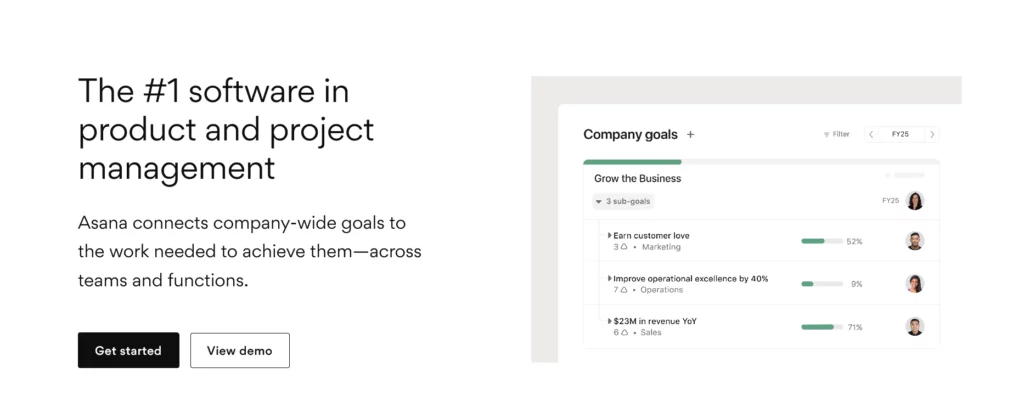
Asana is a versatile SaaS project management tool for efficient project organization, task management, collaboration, customization, and integration with third-party tools.
Pros:
- Asana features an intuitive interface for easy adoption.
- Suitable for various industries and project types.
- Enables real-time communication, reducing the need for external tools.
- Enhances productivity with extensive third-party app integration.
Cons:
- Some users may experience a learning curve, especially with advanced features.
- Larger teams or organizations may find the cost significant, particularly for advanced features.
- Some users might feel overwhelmed by the abundance of features.
2. Trello
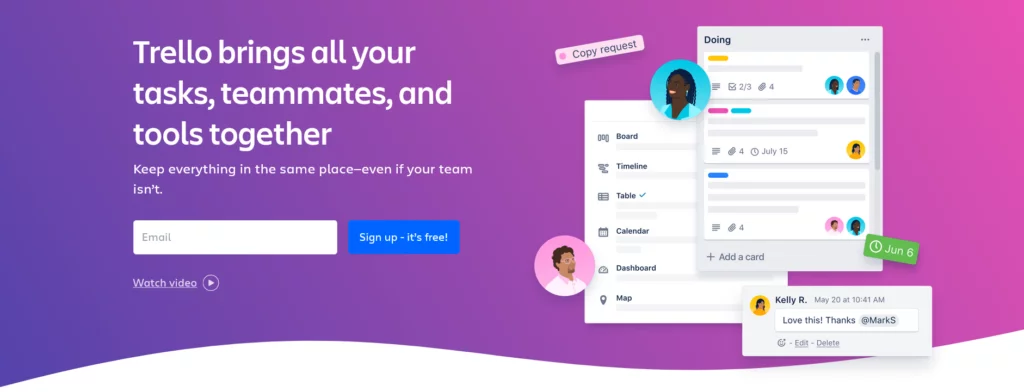
Trello is a SaaS (Software as a Service) tool that offers a visual and user-friendly approach to project management and task organization. Its Kanban-style boards, task cards, and collaborative features make it a popular choice for teams and individuals looking to streamline work processes and improve project visibility. With its flexibility and extensive integration options, Trello can adapt to various project types and workflows, making it a versatile tool for enhancing productivity and teamwork.
Pros:
- Trello’s visual Kanban boards enable quick comprehension of project status.
- It is known for its simplicity and minimal learning curve, making it accessible to teams of all sizes.
- Robust collaboration features foster effective communication and teamwork.
- Extensive integration options seamlessly connect Trello with other tools for added functionality.
Cons:
- Trello’s simplicity may need to be revised for teams needing advanced project management capabilities.
- While suitable for many teams, Trello’s free version may have limitations as organizations expand.
- Managing task dependencies can be more challenging in Trello than in other tools.
3. Monday.com
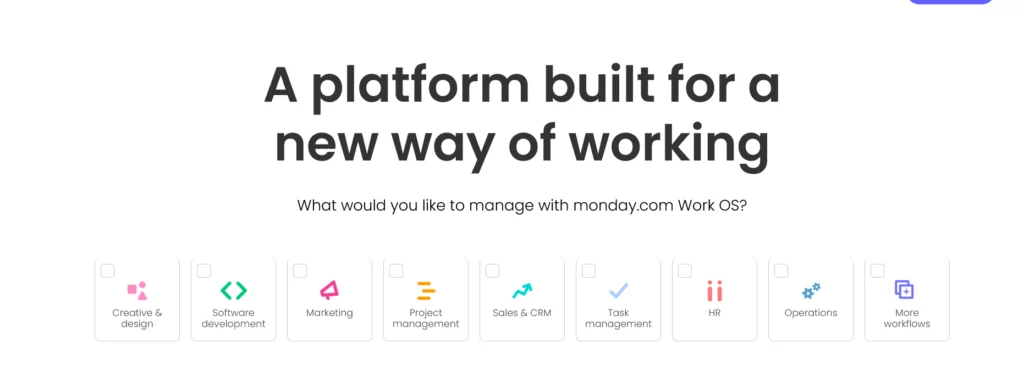
Monday.com is a SaaS (Software as a Service) tool that provides a comprehensive work operating system for teams and organizations. It offers a highly visual and customizable platform for managing projects, tasks, and workflows. Monday.com is known for its flexibility, allowing users to create tailored workspaces and boards to fit their needs. It aims to improve efficiency, transparency, and collaboration within teams, making it a valuable tool for modern businesses seeking to streamline their work processes and achieve better project management outcomes.
Pros:
- Thanks to its customizable boards, Monday.com adapts to various work styles and industries.
- Its intuitive interface minimizes the learning curve, making it accessible to many users.
- Robust automation capabilities enhance efficiency by reducing manual tasks and increasing productivity.
- The tool’s wide range of integrations helps users centralize their work processes.
Cons:
- The cost can become significant for larger teams or organizations, especially when opting for advanced features.
- While versatile, Monday.com may have a steeper learning curve for some users, particularly when implementing automation and complex workflows.
- Some users may find the extensive feature set overwhelming for their specific needs.
4. Jira
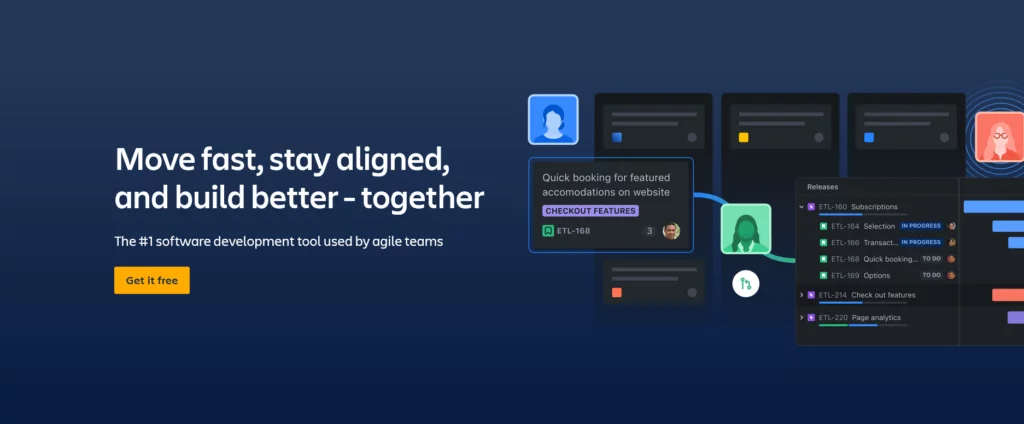
Jira, developed by Atlassian, is a powerful Agile project management tool known for its adaptability and efficiency in facilitating project planning and tracking. Key features include its alignment with Agile methodologies, comprehensive issue tracking, extensive customization options, robust reporting and analytics tools, and seamless integration capabilities with a wide range of Atlassian and third-party applications. These features make Jira a preferred choice for teams seeking to enhance their project management processes and productivity.
Pros:
- Designed with Agile methodologies in mind, making it a natural fit for Agile project management.
- Highly customizable to accommodate different team structures and project needs.
- Offers powerful reporting and analytics tools for project visibility and decision-making.
- Extensive integration options for seamless connectivity with other tools.
Cons:
- The wide range of features and customization options can overwhelm new users or small teams.
- Depending on the chosen plan and the number of users, Jira’s cost can become substantial for larger organizations.
- Learning to navigate and fully utilize Jira’s features can take time, especially for less experienced users.
5. Wrike
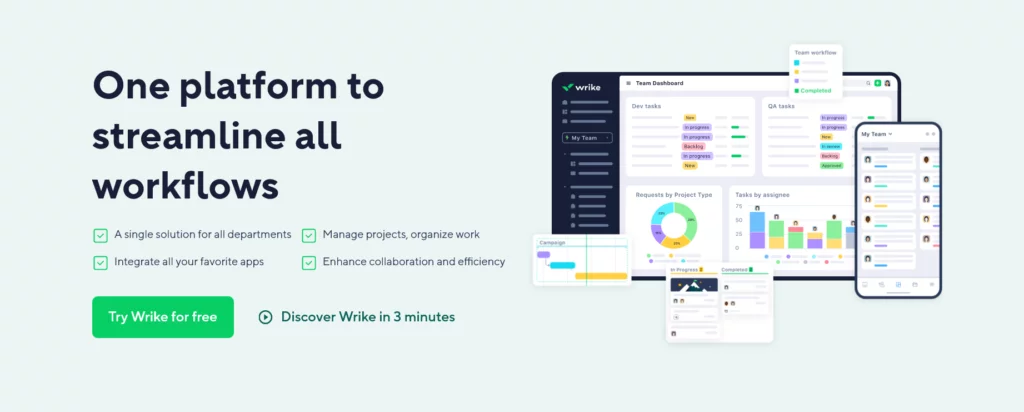
Wrike allows teams to easily create, assign, and track tasks, providing transparency into project progress and deadlines. Its flexibility suits various project types and industries, from marketing campaigns to software developmenWith Wrike, teams can enhance their productivity, communication, and project visibility, making it a valuable tool for modern businesses striving for efficient project management.
Pros:
- Offers advanced task and project management features.
- Effective collaboration tools enhance teamwork.
- Highly adaptable to various work processes.
Cons:
- Some users may find the learning curve steep, especially when using advanced features.
- Higher-tier plans can be expensive for larger teams or organizations.
6. Smartsheet
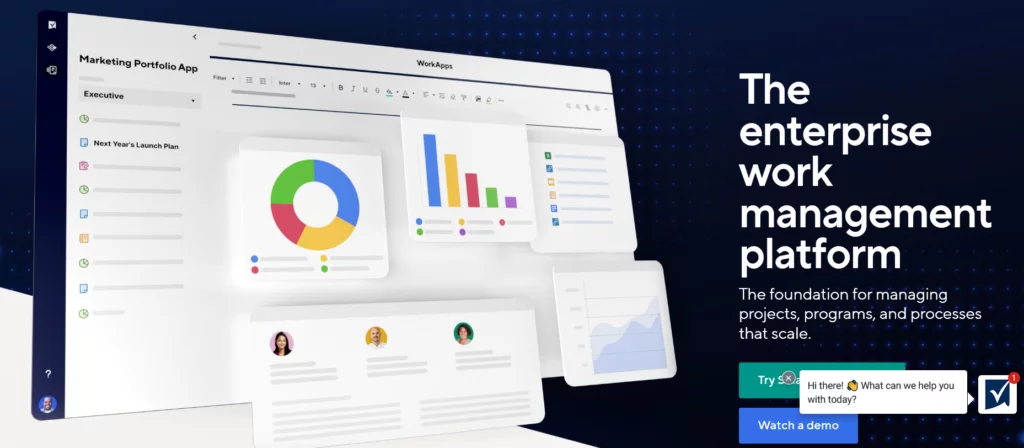
Smartsheet is a versatile project management SaaS (Software as a Service) platform that provides a comprehensive suite of tools for planning, tracking, and managing projects. It combines the flexibility of spreadsheets with project management capabilities, offering a unique approach to project collaboration. The key features include Gantt charts, customizable templates, real-time collaboration, automated workflows, and integration with various third-party apps. Smartsheet’s adaptability suits multiple industries and project types, making it a valuable SaaS solution for organizations seeking effective project management and enhanced collaboration.
Pros:
- Familiar interface for many users.
- Offers robust Gantt chart capabilities for project visualization.
- Enhances efficiency by automating repetitive tasks.
Cons:
- It may not be suitable for highly complex projects with intricate dependencies.
- Costs can escalate for larger teams or enterprises.
7. Salesforce
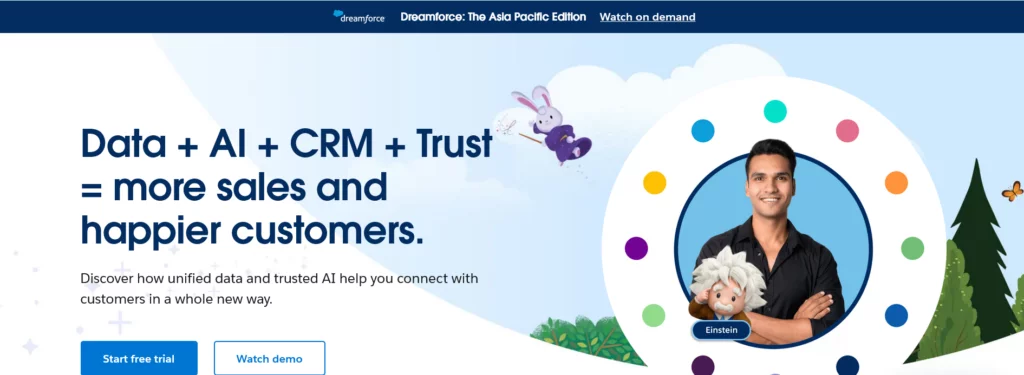
Salesforce stands as a cornerstone in the world of Customer Relationship Management (CRM) software, providing businesses with a versatile platform to streamline their sales, marketing, customer support, and analytics processes. At its core, Salesforce empowers organizations to forge stronger, more meaningful relationships with their customers by centralizing and optimizing data and interactions.
Pros:
- Businesses can adapt the platform to their unique needs and industry-specific requirements. This flexibility ensures that Salesforce can accommodate a wide array of business models and workflows.
- Through its AppExchange marketplace, Salesforce offers access to a vast ecosystem of third-party apps and services. This extensive integration capability allows for a seamless connection between Salesforce and various other tools, enabling organizations to build comprehensive software ecosystems.
- Salesforce provides businesses with the analytical firepower needed to make data-driven decisions. It offers an array of analytics and reporting tools that allow organizations to gain deeper insights into their customer data, sales pipelines, and marketing campaigns.
- Whether you’re a small startup looking to establish a foothold or a multinational corporation managing thousands of customers, Salesforce scales effortlessly. It grows with your business, ensuring that you have the tools and capacity needed to succeed at any stage.
Cons:
- The versatility and power of Salesforce come at a price, which can be a significant hurdle for smaller businesses with limited budgets.
- In-depth knowledge or training may be required to utilize advanced features effectively.
- While Salesforce’s feature-rich environment is an asset, it can be overwhelming for new users. Some individuals find the user interface complex, especially when navigating the extensive range of features and functionalities.
8. Slack
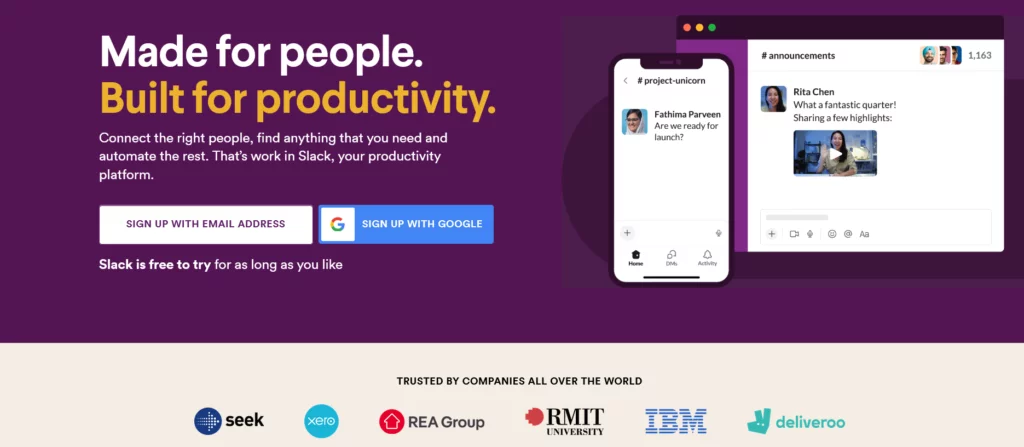
Slack revolutionizes team communication and collaboration with its intuitive and feature-packed platform. Designed to boost productivity and streamline teamwork, Slack facilitates real-time messaging, file sharing, and a rich ecosystem of integrations to enhance overall business communication.
Pros:
- Slack’s real-time messaging capability ensures that team members can communicate instantly, fostering quicker decision-making and collaboration across the organization.
- Slack’s strength lies in its integration capabilities. It seamlessly connects with a wide array of third-party apps and services, creating a central hub for communication and information sharing.
- The organizational structure revolves around channels, allowing teams to categorize conversations and files neatly.
- Slack boasts a powerful search function, enabling users to locate past conversations, files, and information swiftly.
Cons:
- While Slack offers a free version, costs can accumulate for larger teams or organizations requiring advanced features.
- Slack’s constant stream of notifications can sometimes prove distracting for users. Careful management of notification settings is necessary to strike the right balance between staying informed and maintaining focus.
- Organizations with extensive video conferencing needs might consider supplementary solutions.
9. Zoom
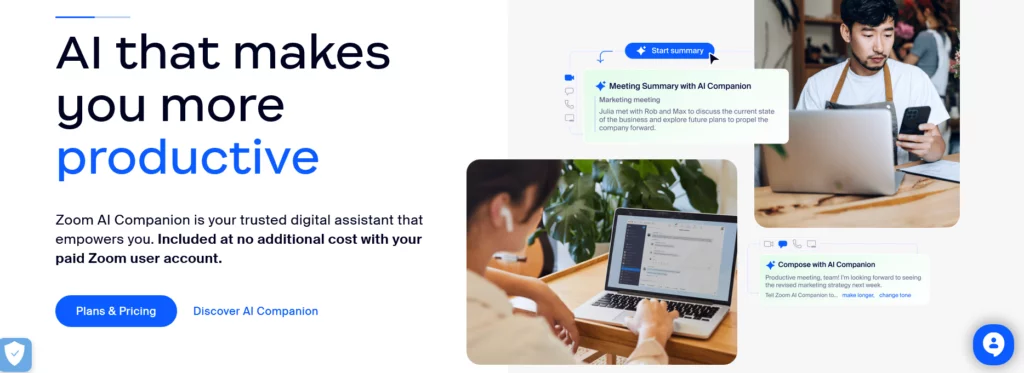
Zoom has emerged as a cornerstone in the realm of virtual communication and collaboration, renowned for its seamless video conferencing and online meeting capabilities. Its user-friendly interface and high-quality audio and video have made it a go-to solution for businesses worldwide.
Pros:
- The interface is designed with user-friendliness in mind. Scheduling and joining meetings are effortless tasks, making it accessible to users of all technical backgrounds.
- Zoom’s commitment to high-quality video and audio conferencing ensures that every virtual interaction is crystal clear and professional.
- Includes robust screen sharing and recording features to allow for effective presentations and the creation of valuable meeting records, enhancing collaboration and documentation.
- Zoom’s large participant capacity accommodates meetings and webinars involving a significant number of attendees. This scalability is ideal for organizations with diverse and widespread teams or audiences.
Cons:
- Zoom has faced security concerns and vulnerabilities in the past; it’s crucial for organizations to stay vigilant and follow best practices for securing meetings.
- The free version of Zoom imposes limitations on meeting duration and participant count, which could be restrictive for longer or larger meetings. Businesses with extensive virtual communication needs may need to invest in a paid subscription.
- While Zoom excels in its core function of video conferencing, its integration capabilities with other collaboration tools may be more limited compared to all-in-one platforms.
Factors to Consider Before Choosing a SaaS Tool:
1. Project Requirements:
Begin by meticulously understanding the unique needs of your projects. Determine whether they are primarily task-based, time-bound, or complex with intricate dependencies. Delve into your projects’ methodology, Agile, Waterfall, or another approach, as certain tools are inherently better suited to specific methodologies.
2. Team Size and Structure:
Take into account the size of your team. Recognize that some tools are ideally tailored for smaller teams, while others are designed with scalability for larger organizations in mind. Evaluate your team’s organizational structure and ascertain if the chosen tool supports roles and permissions in alignment with your requirements.
3. Ease of Use:
Assess the tool’s user-friendliness. Consider whether your team members can seamlessly adopt and navigate the platform without complications. Investigate whether the tool provides essential resources such as tutorials, training materials, or onboarding support to facilitate the user experience.
4. Collaboration Features:
Scrutinize the collaboration capabilities of the tool. Examine its capacity to enable real-time communication, document sharing, and collaborative task commenting.
Ensure the tool permits multiple team members to engage in project work, fostering efficient teamwork concurrently.
5. Customization and Flexibility:
Determine the extent of customization the tool offers. Evaluate whether it can be tailored to align precisely with your project workflows and specific requirements. Check if the tool allows you to create custom fields, templates, and automation rules to suit your unique needs.
6. Integration Options:
Evaluate the tool’s integration capabilities and assess whether it can seamlessly integrate with other software and tools your team currently employs. Consider compatibility with communication apps such as Slack or Microsoft Teams, productivity suites like Google Workspace or Microsoft Office, and development tools like GitHub or Jira.
7. Reporting and Analytics:
Investigate the reporting and analytics features of the tool. Determine its capability to generate customized reports and facilitate easy project progress tracking. Verify whether it offers advanced features such as Gantt charts, comprehensive dashboards, and resource allocation tracking.
8. Mobile Accessibility: Ascertain whether the tool provides mobile accessibility through a dedicated mobile app or compatibility with mobile browsers, as this is essential for remote and on-the-go work.
9. Security and Compliance: Conduct a comprehensive review of the tool’s security measures, including data encryption, access controls, and adherence to industry standards such as GDPR. Ensure the tool aligns seamlessly with your organization’s security and compliance requirements.
10. Cost and Scalability: Gain a thorough understanding of the pricing structure, including any potential additional costs associated with scaling as your team or organization expands. – Explore whether the tool offers free plans, trial periods, or discounts catering to non-profit organizations or budget constraints.
11. Customer Support: Evaluate the accessibility and responsiveness of the tool’s customer support. Determine whether the provider offers comprehensive resources such as documentation, tutorials, and responsive support channels.
12. Data Backup and Recovery: Prioritize tools incorporating robust data backup and recovery mechanisms. Data integrity is vital to prevent potential data loss in system failures.
Factors to Consider Before Choosing a SaaS Project Management Tool:
- Robust Task Management Tools: A top-notch SaaS project management tool should offer comprehensive task management capabilities. This includes the ability to create, assign, and delegate tasks efficiently. Look for features like task prioritization, due dates, dependencies, and progress tracking.
- Online Chat and Virtual Meeting Tools: Effective communication is vital for project success. The tool should provide chat functionality for quick updates and discussions. Virtual meeting integration, such as video conferencing and screen sharing, facilitates real-time collaboration among remote or dispersed teams.
- Cost and Budget Tracking: A critical aspect of project management is staying within budget. Seek tools that offer cost and budget tracking features, allowing you to monitor expenses, allocate resources wisely, and ensure projects are financially viable.
- Reporting and Financial Analysis: Robust reporting and financial analysis tools enable you to generate insights from project data. Look for customizable reports that provide visibility into project progress, financial health, and other key metrics. This helps in informed decision-making.
- Custom Templates: Customizability is essential to adapt the tool to your specific project needs. Look for the ability to create and save custom templates for project plans, tasks, or workflows, ensuring consistency and efficiency across projects.
- File Sharing and Collaboration Tools: Seamless collaboration is fundamental. The tool should offer secure file sharing, version control, and collaborative editing features. Integration with cloud storage platforms can also be beneficial.
- Expense Tracking and Invoicing: Efficiently track project-related expenses, generate invoices, and manage payments within the tool. This streamlines financial processes and ensures accurate billing.
- Online Timesheets: Time tracking is vital for project evaluation and resource allocation. Look for integrated timesheet functionality that allows team members to log hours and activities accurately.
- Resource Management: Effective resource allocation is key to project success. The tool should provide resource management features, including resource allocation, workload balancing, and availability tracking.
- Project Scheduling Tools: Robust project scheduling tools help create timelines, Gantt charts, and critical path analysis. These tools assist in visualizing project workflows and dependencies.
To Effectively Manage a SaaS Project, Follow These Strategies:
- Establish Clear Communication Channels: Effective communication is the foundation of successful SaaS project management. Set up transparent communication channels where team members can easily access updates and messages. To keep everyone informed, leverage project management tools to send notifications via email or SMS. Maintain consistency in communication methods and encourage team members to adhere to designated channels.
- Define Your Project Goals: Develop a roadmap with well-defined goals, metrics, and milestones. This roadmap clarifies your team and boosts morale as key milestones are achieved. Consider metrics like adoption scope and timeline for completion. Specify when these goals should be reached and assign responsibility to teams or departments for their accomplishment.
- Identify and Mitigate Risks: Recognize potential project risks such as time constraints, expertise gaps, or resource limitations. Early identification is crucial to prevent these issues from escalating. Create a risk mitigation plan promptly to minimize potential setbacks.
- Utilize SaaS Project Management Tools: Leverage SaaS project management tools for efficient execution. These tools are essential for resolving issues and managing project complexities. Choose tools that align with your current needs and possess the flexibility to adapt as your projects evolve. They simplify the problem-solving process and enhance project success.
- Tailor Management Methodologies: Tailor your project management approach to match the unique needs of each project. While customization is key, consider established frameworks that may align with your project type:
- Agile Approach: Ideal for projects with cyclical task lists, Agile promotes adaptability and frequent iterations.
- Waterfall Approach: Suited for projects with a sequential task structure where each step must be completed before progressing to the next
Conclusion:
SaaS project management tools have revolutionized how teams and organizations approach project planning, execution, and collaboration. These cloud-based solutions offer many features and benefits, including flexibility, scalability, real-time collaboration, and accessibility from anywhere with an internet connection.
The right SaaS project management tool choice depends on your specific needs, team size, and project requirements. Whether it’s Trello’s visual simplicity, Jira’s Agile-centric approach, or Smartsheet’s blend of spreadsheets and project management, there’s a tool for every team and project.
FAQs on SaaS Project Management:
Are SaaS project management tools secure?
Most reputable SaaS providers implement robust security measures to protect user data. However, reviewing their security features, compliance certifications, and data encryption policies is essential to ensure they meet your organization’s security requirements.
Can SaaS project tools integrate with other business software?
Many SaaS project management tools offer integrations with popular business apps like Slack, Microsoft Office, and Google Workspace. Integrations can streamline workflows and enhance productivity.
How can I ensure the successful adoption of a SaaS project management tool in my organization?
Provide proper training, create clear guidelines for tool usage, and involve team members in the decision-making process. Regularly assess the tool’s effectiveness and make adjustments to ensure it aligns with your team’s evolving needs.



